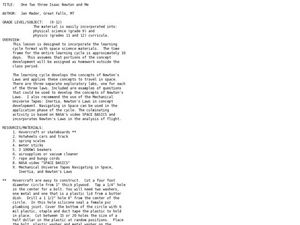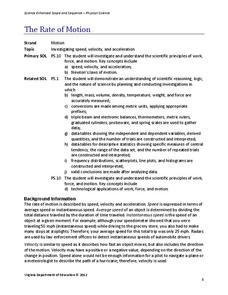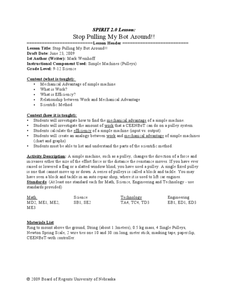Curated OER
Newton's Second Law
Three memorable activities build on each other to give physics masters a firm grasp of Newton's Second Law. Pupils play with a lab cart on a flat surface and on an incline to confirm that force is equal to mass times acceleration. In the...
Curated OER
Law of Conservation of Momentum
A suggested sequence of events lays out five hands-on activities and four creative assessments on the conservation of momentum. Using spring scales and mail scales, junior physicists examine Newton's Third Law. After you have taught the...
Curated OER
Laws of Motion
Do you need some new ideas for teaching Newton's Laws of Motion? This series of activities will spring your curriculum to life! Choose from five activities to demonstrate or have your science stars perform. As a result, they will have...
Curated OER
One, Two, Three--Isaac Newton and Me
Students experiment to develop understanding of Newton's Laws and how they apply to space travel in this ten day lesson sequence.
Curated OER
Newton's Third Law of Motion
Students explore Newton's 3rd Law of Motion. In this physics instructional activity, students participate in various experiments that demonstrate the idea of action/reaction, such as a balloon launch, a skateboard activity, and a spring...
Curated OER
The Lost Newton's Laws Lesson
Students explore momentum. In this physics lesson, students perform an experiment in which two balls are released on slanted boards while students observe which ball will go the farthest and the fastest. Students define and explain...
Curated OER
One Two three Isaac Newton and Me
Ninth graders study Newton's Laws and apply these concepts to travel in space. In this space lesson students complete several lab activities.
Cornell University
The Physics of Bridges
Stability is key when building a bridge. Scholars explore the forces acting upon bridges through an analysis of Newton's Laws and Hooke's Law. The activity asks individuals to apply their learning by building a bridge of their own.
Curated OER
Newton's Earthquake
Learners discuss Newton's 2nd and 3rd laws using the example of a football linebacker and a small child pushing against each other on an ice rink. Students are able to visualize the results of the push and link it to the laws. Discussion...
Curated OER
Newton's Third Law
Learners use inquiry and observation to explore Newton's third law of motion: for every action there is a reaction. In this physics activity, students rotate through six stations set up with materials and picture directions illustrating...
Curated OER
Mass, Volume, and Weight
Students explore mass, volume, and weight. In this science and measurement instructional activity, students compare volume, mass, and weight after listening to the teacher's description of each. Students explore different scales and...
Curated OER
Seesaws
Students make direct comparisons between objects using balance and spring scales. They also are encouraged to estimate which object is heavier by holding the objects before using the balance scales. Comparing the masses of objects is the...
Curated OER
Sliding and Stuttering
Ninth graders use a spring scale to drag an object such as a ceramic coffee cup along a table top or the floor. The spring scale allows them to measure the frictional force that exists between the moving cup and the surface it slides on....
Curated OER
Challenger's Lost Lessons - The Lost Simple Machines Lesson
Students investigate the characteristics of simple machines. In this simple machine lesson, students investigate work as a product of applying constant force. They answer questions about what happens on Earth and what may have happened...
Virginia Department of Education
The Rate of Motion
How much time does it take to jump over three balloons? Pupils calculate the speed of tasks that require different motions. They determine motions for tasks such as walking, skipping, hopping, and jumping before creating a spreadsheet...
University of Texas
Free-Body Diagram
Preparing for an AP test is about more than bubble sheets and memorization. The two activities in this resource require a direct application of skills learned throughout an AP Physics course.
Curated OER
Stop Pulling My Bot Around!
Learners investigate the relationship between work and mechanical advantage. In this physics lesson, students calculate the work and efficiency of pulleys. They identify the different types of pulleys.
Curated OER
Inclined Plane and Pulley
Students describe how inclined plane and pulleys make work easier. In this physics lesson plan, students calculate work done and mechanical advantage of both simple machines. They collect data from the experiment and construct graphs.
Curated OER
Experiments with Levers
Students investigate levers. In this simple machine lesson, students study levers and the mechanical advantage of using levers. They will collect data and illustrate their systems for eight different tests.
Curated OER
The Law of Inertia
Students practice the 4 question strategy to form more questions and develop further experiments. The four questions are engage, explore, explain, and elaborate. They use the 4 question strategy on an investigation involving the mass...
Curated OER
Work
Ninth graders determine when work is being done on an object. They define work and calculate work for several examples. They define and give examples of force and distance and define power and calculate power. They determine the...






















